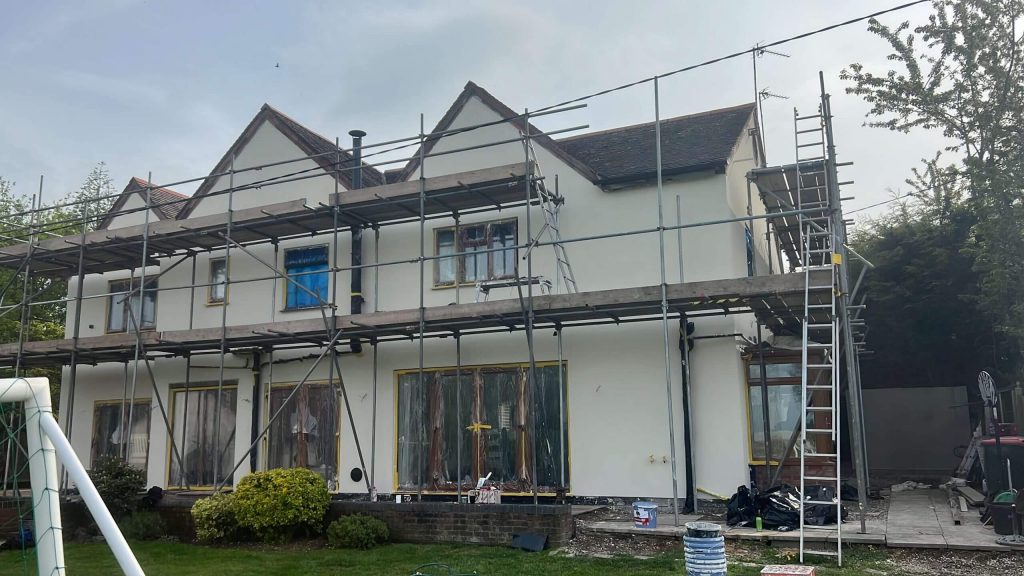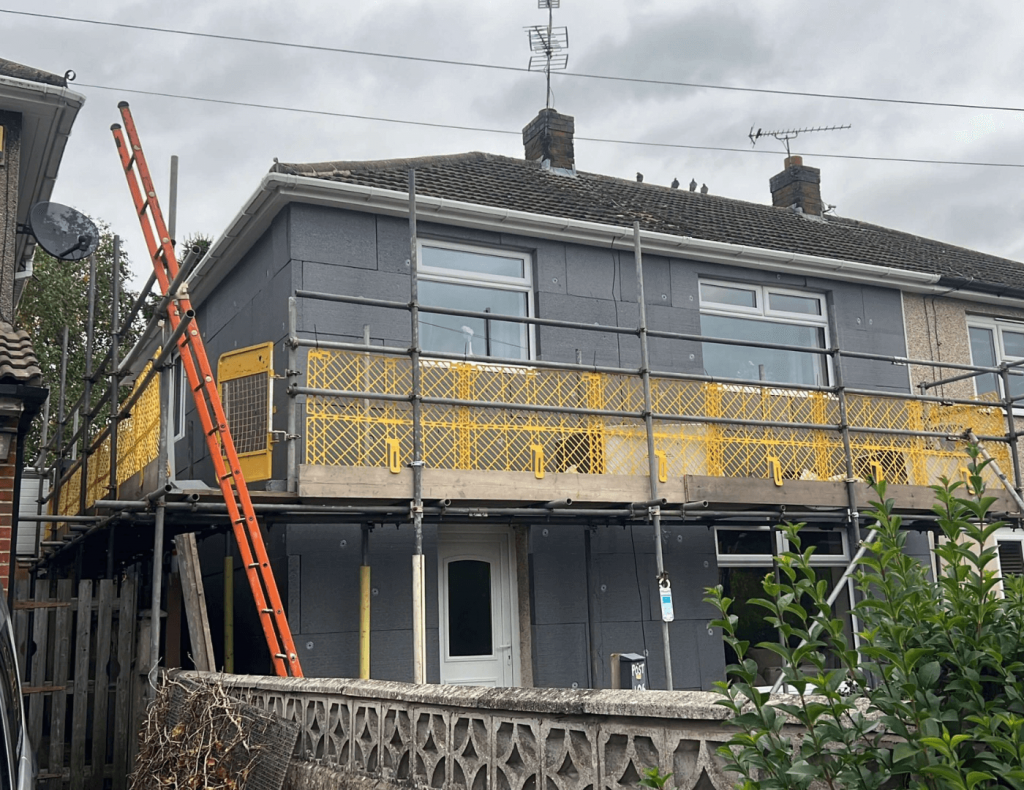External Wall Insulation (EWI) is a highly effective way to improve the energy efficiency of a home by insulating its exterior walls. It involves applying a layer of insulation to the outside of your property and then rendering or cladding it for both thermal efficiency and aesthetic appeal.
Homeowners are increasingly turning to EWI due to its ability to reduce energy bills, enhance comfort, and add value to properties. The cost of installing EWI can vary depending on various factors.
In this article, we’ll discuss the factors that influence the price, giving you a clear understanding of the costs involved before considering this upgrade for your home.
Article Contents:
- How much does External Wall Insulation Cost?
- What Factors Determine the Cost of EWI
- External Wall Insulation Cost per m2
- Costs to Insulate a 3-Bedroom House
- Is External Wall Insulation Expensive
- Government Grants for External Wall Insulation
How Much Does External Wall Insulation Cost?
The cost of External Wall Insulation (EWI) varies based on several factors such as material choice, property size, and location. Here are some cost examples for insulating different types of homes with External Wall Insulation (EWI):
- Terraced House
For a terraced home (typically with two storeys and shared walls on either side), the cost of EWI generally falls between £6,000 – £8,000 for materials and installation, depending on the type of insulation material used. A budget-friendly option like EPS could cost around £6,500, while using a higher-performance material like Phenolic might increase the cost to £7,500. - Semi-Detached House
A semi-detached property, with one shared wall, tends to be larger and more expensive to insulate than a terraced house. The cost for EWI for a 3-bedroom semi-detached house is typically between £7,500 – £9,000. For example, using EPS could bring the cost to around £8,000, while opting for Rockwool might push the total to £9,000. - Detached House
Detached houses have the highest external wall surface area to insulate, and as a result, EWI costs are higher. For a typical 3-bedroom detached house, the price for EWI installation ranges from £10,000 – £15,000. The material choice can significantly impact the final cost; for example, Phenolic could push the price up to £14,000, while EPS may keep it closer to £11,000.
These figures include materials, labour, and additional costs such as scaffolding and surface preparation. It’s important to seek detailed quotes from reputable providers of External Wall Insulation in your area, this will ensure you get precise estimates tailored to your specific needs and property.

What Factors Determine the Cost of EWI?
1. Material Costs
The type of insulation material you choose for EWI has a significant impact on the overall cost. The most common materials include:
- EPS (Expanded Polystyrene): Budget-friendly and widely used. It offers good thermal performance at a lower cost.
- Rockwool: Known for its excellent fire-resistant properties. While it can be more expensive, it’s highly effective in noise insulation as well.
- Phenolic: The most efficient insulation material in terms of thermal performance, though it tends to come with a higher price tag.
Each material has distinct performance characteristics, which will influence your long-term savings on energy bills.
Our recommendation would be to understand what material is used for external wall insulation and then pick based on your preferences, and get in touch with reputable companies for assistance.
2. Labour Costs
Skilled labour is essential for proper EWI installation. Due to the need for technical expertise and precision, the installation process can be labour-intensive. As a result, UK homeowners typically face higher labour costs compared to simpler forms of home improvement.
The average cost for professional EWI installation ranges between £50 – £70 per m², depending on complexity and location.
3. Property Size
Larger properties naturally incur higher costs due to the increased surface area that requires insulation. For example, insulating a 2-bedroom semi-detached house will be more affordable than a 3-bedroom detached property. A specific cost guide based on property size can help homeowners gauge their potential investment better.
4. Wall Condition
The condition of the walls can significantly affect pricing. If your exterior walls need preparation, such as cleaning, repairs, or treatment to ensure better adhesion for the insulation material, this can add extra costs. Homes with damaged or uneven walls will incur higher preparation costs.
5. Thickness of Insulation
The thicker the insulation, the better the thermal performance, but this comes at an increased cost. The optimal thickness will depend on your energy efficiency goals and budget. Thicker insulation can reduce energy costs further but requires more material and, in turn, more expensive installation.
6. Regional Price Differences
Location plays a key role in the cost of external wall insulation. In London and major cities, the cost can be higher due to labour availability and higher living costs. Rural areas may offer lower prices but could have fewer qualified contractors available.
How Much Does External Wall Insulation Cost Per m²?
The cost of External Wall Insulation (EWI) can vary widely depending on the material used. Below is a break down on the cost per square metre for EWI:
| Material | Cost per m² |
|---|---|
| EPS | £50 – £65 |
| Rockwool | £60 – £75 |
| Phenolic | £70 – £90 |
In addition to the cost of materials, other factors contribute to the total price. For example, scaffolding is often necessary for the safe installation of EWI, adding £10 – £20 per m². Surface preparation, such as cleaning or repairing the walls, could also increase the cost by £5 – £15 per m². Additionally, if you choose a specific render finish (e.g., coloured or textured), this will incur further charges.

Is External Wall Insulation Worth It?
External wall insulation (EWI) is a significant investment, but the long-term benefits often outweigh the initial cost. Here’s why it can be a worthwhile upgrade for your home:
Cost vs. Savings
The cost of EWI varies depending on factors such as material choice, labor rates, and wall condition. On average, homeowners can expect to pay:
- 2-bedroom semi-detached house: £5,000 – £7,000
- 3-bedroom semi-detached house: £7,500 – £9,000
- Detached house: £10,000 – £15,000
For instance, insulating a 3-bedroom semi-detached house with EPS could cost around £8,000, while a premium material like Phenolic might push the price to £11,000.
Energy Efficiency & Reduced Bills
EWI significantly improves insulation, reducing heat loss and lowering energy bills. Many homeowners see savings of up to 25% on heating costs, making it a cost-effective solution in the long run.
Increased Property Value
A well-insulated home is more attractive to buyers, potentially increasing property value. EWI also enhances the home’s external appearance, improving curb appeal.
Comfort & Sustainability
By maintaining a more stable indoor temperature, EWI creates a more comfortable living environment year-round. It also reduces carbon emissions, contributing to a more sustainable home.
The Verdict
While external wall insulation requires an upfront investment, the combination of lower energy bills, improved home comfort, and potential property value increases makes it a worthwhile option for many homeowners. Additionally, grants may be available to help offset costs, making it an even more attractive investment.
Why is External Wall Insulation So Expensive?
So you might be thinking “Why is External Wall Insulation so Expensive?”, but the main drivers of EWI’s high cost are the expensive materials and skilled labour required for installation. Premium insulation materials such as Phenolic offer superior energy efficiency, but they come with a high price tag. Labour costs are similarly high due to the need for experienced installers who ensure the insulation is applied correctly and safely.
In addition, government regulations such as PAS 2035 and the need for specific U-values can add to the cost. Compliance with these standards ensures that the insulation meets the necessary energy efficiency standards, which can be costly but is essential for proper installation.
Can You Get a Government Grant for EWI?
Yes, several government schemes can help homeowners cover the cost of EWI. The Eco4 Scheme and the Great British Insulation Scheme offer funding for energy-saving home improvements, including external wall insulation.
Eligibility depends on factors such as income, property type, and existing energy performance. Low-income households or those receiving benefits may qualify for free insulation under these schemes. However, the availability of grants varies, and you should check the current eligibility criteria and apply through certified contractors.
To find out more about the grants, visit our detailed blog post “What Grants Are Available for EWI?”
Conclusion
External Wall Insulation can be a significant investment, but it offers long-term savings on energy bills, increased property value, and improved comfort. The overall cost depends on various factors, including material choice, labour, property size, and wall condition. While EWI may seem expensive initially, government grants and the potential for future savings make it a worthwhile consideration.
If you’re considering EWI for your home, get in touch with us today for a free quote and find out how much it could cost to insulate your property!

